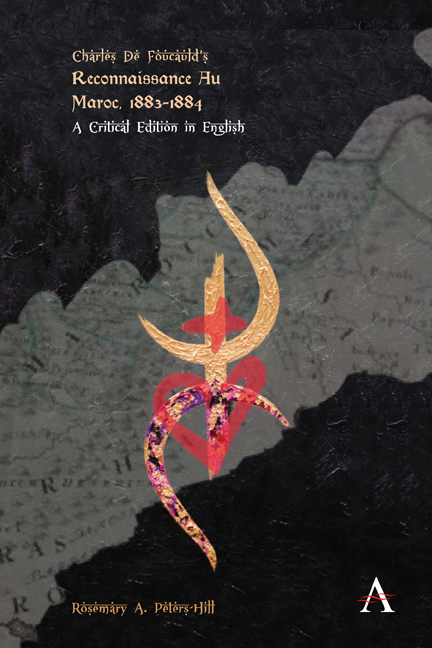Book contents
- Frontmatter
- Contents
- List of Figures
- Acknowledgments
- “There are no roads”: Charles de Foucauld’s Reconnaissance au Maroc—a Critical Introduction
- Charles de Foucauld, Reconnaissance au Maroc, 1883–1884
- Letter to François de Bondy
- Introduction
- Avant-Propos
- I Tangiers to Meknès
- II Meknès to Qaçba Beni Mellal
- III Qaçba Beni Mellal to Tikirt
- IV Tikirt to Tissint
- V Sojourn in the Sahara
- VI Tissint to Mogador
- VII Mogador to Tissint
- VIII Tissint to the Dadès
- IX The Dadès to Qçabi ech Cheurfa
- X Qçabi ech Chorfa to Lalla Maghnia
- Appendix: The Jews of Morocco
- Note on the Materials Used to Draw Up My Itinerary
- Report Delivered to the Société de Géographie de Paris in Its General Session of 24 April 1885
- “Itineraries in Morocco”
- Afterwards: An Afterword
- Glossary of Terms
- Bibliography
- Index
X - Qçabi ech Chorfa to Lalla Maghnia
Published online by Cambridge University Press: 20 January 2022
- Frontmatter
- Contents
- List of Figures
- Acknowledgments
- “There are no roads”: Charles de Foucauld’s Reconnaissance au Maroc—a Critical Introduction
- Charles de Foucauld, Reconnaissance au Maroc, 1883–1884
- Letter to François de Bondy
- Introduction
- Avant-Propos
- I Tangiers to Meknès
- II Meknès to Qaçba Beni Mellal
- III Qaçba Beni Mellal to Tikirt
- IV Tikirt to Tissint
- V Sojourn in the Sahara
- VI Tissint to Mogador
- VII Mogador to Tissint
- VIII Tissint to the Dadès
- IX The Dadès to Qçabi ech Cheurfa
- X Qçabi ech Chorfa to Lalla Maghnia
- Appendix: The Jews of Morocco
- Note on the Materials Used to Draw Up My Itinerary
- Report Delivered to the Société de Géographie de Paris in Its General Session of 24 April 1885
- “Itineraries in Morocco”
- Afterwards: An Afterword
- Glossary of Terms
- Bibliography
- Index
Summary
Qçabi ech Chorfa to Outat Oulad el Hadj
8 May. Departure from Qaçba el Makhzen at six o’clock in the morning. The Mlouïa, at the base of the qaçba, is 20 meters across, with steep, rocky banks three or four meters high, and deep yellow water. There is no ford here: I cross the river a bit farther on, where it is 25 meters across but only 1m20 deep, with a fast current; the bed is half sand, half shingle. After crossing, I leave the furrow the river flows in (and which remains full of growth); it is bordered to the left by a half-sand, half-rock bank, which I climb: when I reach the top, I find myself in a long plain marked out to the south by the Mlouïa, to the north by the first slopes of the Middle Atlas. The plain is three to six kilometers wide, depending on the place: an abrupt bend in the river limits it near here, to the west; to the east, it extends out two-thirds of the distance between El Qçâbi and Misour, where it runs into a group of high rocky hills at whose base it ends. It is a wavy plain, cut across by many ravines; its ground is half sand, half gravel, most of the time barren of vegetation, and red in color, like the spartan mountains that edge it to the north. I start into this plain, where I will travel until eight o’clock: then I re-descend and cross the Mlouïa: the river flows in its hollow full of crops and qçars; this is still the district of Qçabi ech Chorfa. The river has the same depth, the same water laden with earth as at the previous ford; 30 meters wide. As soon as I reach the right bank, I climb the embankment that lines the narrow sides and am back in the plain.
Near the place where I have just crossed the Mlouïa, the village of Aït Blal rises up on its banks. I left Qçabi ech Chorfa with three zetats, two Chellaha from the Aït Blal and an Arab from the Oulad Khaoua.
- Type
- Chapter
- Information
- Charles de Foucauld’s Reconnaissance au Maroc, 1883–1884A Critical Edition in English, pp. 353 - 374Publisher: Anthem PressPrint publication year: 2020



